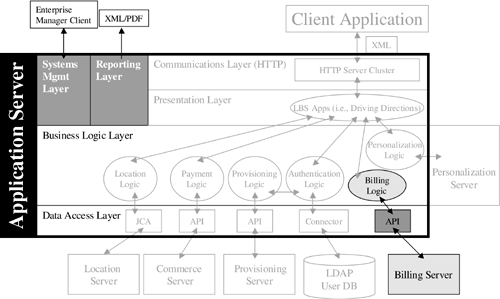Chapter 8. Billing
This chapter focuses on the billing system required for mobile location services, as shown in Figure 8.1. Mobile operators and auto manufacturers are both interested in the potential incremental revenues of mobile location service applications. To make them successful, it is important not only to have the right technology, but also to have the right business model. The pricing models available to most mobile operators today are very simple. Wireless data, whether GPRS or WAP, is typically charged for based on either number of minutes or bytes transferred, and there is no visibility into the content itself. Business models used by the telematics service providers in the automotive space are also very simplistic, and often based on a flat monthly fee.
Figure 8.1. Billing Components of a Mobile Location Service Architecture.

Like the many unsuccessful advertising-based business models tried by dot-coms in 1999, business models that do not cover the cost of providing service and generate profits will not survive. It is clear that the business models for wireless data and location services, whether provided by mobile operators or telematics service providers, must be much more flexible and creative, and are likely to change dramatically. Many European mobile operators have attempted to provide applications and services on their mobile network using a "walled garden" approach, which limits wireless data access to a small number of applications developed by the mobile operator's content division. In many cases, access to competing services is blocked. These initiatives have not been very successful, and it is difficult to argue that mobile operators have a core competence in this area. If Microsoft had designed Windows 3.1 with a closed interface and tried to build all the software applications that were bundled at the product's launch themselves, Windows 3.1 would not have been the success it was.
For wireless data and location-based applications to be truly successful and build a mass market, open standards and an open application programming interface is required. NTT DoCoMo has experienced considerable success with its open wireless data business model that charges subscribers per byte transferred, with a percentage being paid back to the content provider.
Location-based services are highly complex and they require a very expensive infrastructure. For mobile operators and telematics service providers to recoup their infrastructure investment requires an even more sophisticated and more flexible business model that can involve third-party application developers. It is important to be able to provide pricing models that bill subscribers and compensate application developers, and involve more than just the number of bytes transferred (e.g., charging application developers on a per-usage basis for specialized services like subscriber positioning, and providing them with prepackaged business models and billing services).







